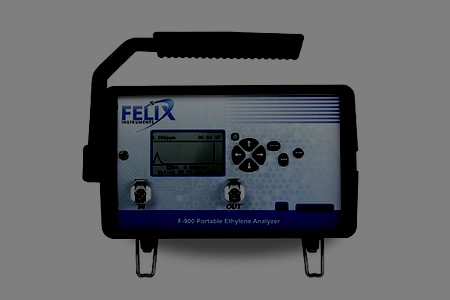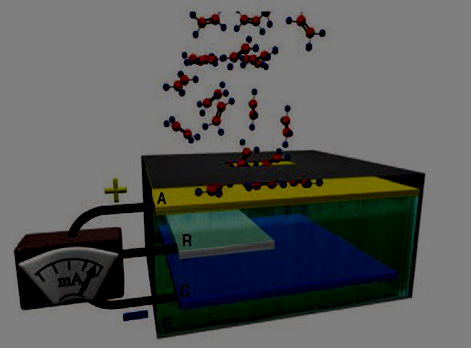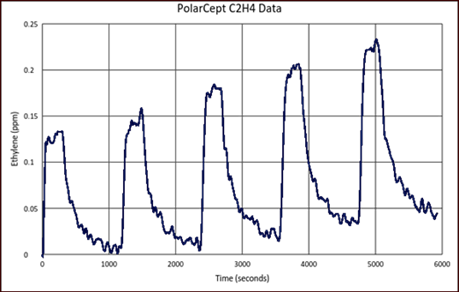Unique equipment for measuring of ethylene, CO2 and O2
It is the first truly mobile solution for monitoring and analysing of ethylene emissions, unique in our country.
Introduction
The F-900 Portable Analyzer enables accurate real-time measurement of ethylene concentration, both in a laboratory and outside. The F-900 uses electrochemical sensors as well as several other sensors for temperature, humidity, GPS location and optionally carbon dioxide (CO2: high and low range) and oxygen (O2). During analysis, the examined gas moves across the electrode surface and diffuses into an electrochemical cell where ethylene is oxidised. The current produced by the oxidation is measured and interpreted as the ethylene concentration (reported in parts per million or ppm). The electrochemical sensor is very sensitive to ethylene, detecting it at levels as low as 0.025 ppm (25 ppb) in the air.

source: F-900 instruction manual
Functions:
- High sensitivity to C2H4 (0 ppm - 200 ppm)
- Ability to detect CO2 (range 0% - 20%) and O2 (range 0% - 100%)
- Compact, portable housing, up to 5 hours of field monitoring
- Continuous real-time monitoring
- Multiple configurations for in situ testing and controlled atmosphere monitoring
- Non-destructive product measurements
- Measurement of individual fruit; fruit in containers
- Work in conditions 0°C - 45°C (0% - 90% humidity without condensation)
- Nominal range of 0 ppm - 200 ppm, lower efficiency limit of 0.025 ppm (25 ppb), accuracy of ± 5% ± 0.5 ppm
Electrochemical sensor operating principle
Gas samples move across the electrode surface and diffuse into the electrochemical cell where ethylene is oxidised.
The current resulting from the oxidation is then measured and converted to ppm of ethylene.
source: F-900 instruction manual
Accompanying gasses
Gases present in the environment, other than the target gas for measurement, may affect the response of the device.
Ripening fruit release a mixture of hydrocarbons, including ethylene. Oxidation of other gases causes the electrochemical sensor to be unable to distinguish between them. This results in falsely high ethylene levels in the presence of other interfering gases.
Felix Instruments tested a method to absorb some competing gases, providing more accurate ethylene measurements. The PolarCept method, uses distilled water to condition the IN chamber. It has been shown to filter out alcohols and reduce interference from measurement interfering gases.
Example results
The data values obtained are the date and time of the measurement, the ethylene concentration in ppm, the CO2 and O2 concentrations, the gas stream temperature in °C, the relative humidity (RH) of the gas stream in percent, the atmospheric pressure (kPa) and the gas stream flow rate in ml / min. From this example, you can see that when the CO2 or O2 sensor is not in use, its concentration value is zero. 
source: F-900 instruction manual
Above, there is an example of ethylene data plotted for PolarCept, which shows typical peaks and bottoms for the measurement / cleaning cycle. At the end of the cleaning period, ethylene levels should be (below 0.2 ppm).
Usage proposals:
- analyses of ethylene production by ripening fruit stored in controlled-atmosphere refrigeration plants
- analysis of ethylene production in individual fruit
- measurement of low ethylene emissions from small quantities of fruit
- ethylene measurement in apple seed chambers (apple harvest planning)
- ethylene measurement in greenhouses
- control of concentration during transport, limitation of losses due to high ethylene levels
- ethylene measurement during transport and storage of fresh flowers (ethylene is responsible for the 'ageing' of cut flowers)
- flower farming - an increase in concentration indicates readiness for flowering
- measurement of ethylene during production of plastics (polyethylene) (high carbon monoxide content, which is often the result of increased ethylene concentration)
The F-900 Portable Ethylene Analyzer (Felix Instruments, USA) was purchased as a part of the project: "Active fresh food packaging”. Project co-financed by the National Centre for Research and Development as a part of the initiative CORNET ( CORNET/26/1/2019 "FreshIn-Pac”).